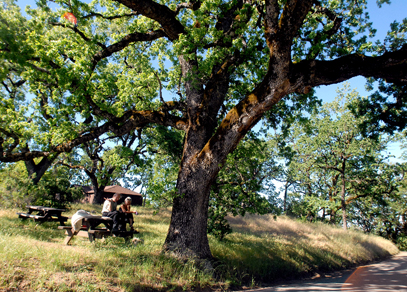Fremont Peak is a destination worth lingering over
What better way to celebrate Gov. Arnold Schwarzenegger’s
decision not to ask the Legislature to close nearly 50 state parks
than by going out and spending time in one?
Fremont Peak is a destination worth lingering over
What better way to celebrate Gov. Arnold Schwarzenegger’s decision not to ask the Legislature to close nearly 50 state parks than by going out and spending time in one?
Faced with a looming budget shortfall, the governor earlier this year proposed a long list of cuts, among them park closures that, together, would save each Californian only 2 cents per month.
Two parks close to home were on the list of 48 headed for closure – enormous Henry Coe in the Diablo Range and small and often-overlooked Fremont Peak, the crown jewel of the Gabilan Range.
People can explore Henry Coe’s 87,000-plus acres for years without seeing it all. Fremont, at 159 acres, is a destination that can be fully appreciated in a weekend.
Getting there takes less than an hour for most San Benito County residents, making it the perfect location for a weekend of peaceful exploring.
The park surrounds Fremont Peak, a rocky limestone crag that is the highest point in the Gabilans. It contains a few miles of hiking trails, a campground and an observatory run by a nonprofit association whose members are generous about sharing their knowledge and their equipment.
Getting there is easy. From Hwy. 156 in San Juan Bautista, visitors should go south on The Alameda, away from San Juan. Just a couple of blocks down, the road forks. Bearing right leads to the San Juan Salinas Grade, hard left heads toward Mission Vineyard Road. Straight is Old Stage Road. A gentle jog to the left leads to San Juan Canyon Road, and that’s the way to go.
The next nine miles are best not rushed. The road leads from grasslands to mixed oak woodlands to chaparral to a pine forest to the park itself. The views and the twisting curves invite a stately pace.
The park is at the end of the road, 3,000 feet higher than where you began in San Juan. Its 25 campsites are set in a grove of black oaks. Many of the sites offer breathtaking views of Central California. A short stroll to the upper parking area or, better yet, a ramble to the peak’s summit reveals a view that stretches the length of Salinas Valley and across the sweeping curve of Monterey Bay.
The campground is seldom full, but with gasoline prices climbing and people looking for outings closer to home most sites may be reserved online by visiting www.reserveamerica.com. A call to the area parks office revealed that the staff always holds a few spaces for casual visitors. Most are for groups of eight people or fewer, but a group site can accommodate up to 50.
Wildlife is abundant. On one visit, the only other person in the park was peering underneath stones, looking for Jerusalem crickets. More than once, we’ve encountered snakes, including rattlesnakes. Far more common are deer and the abundant birdlife.
The park exists because Fremont Peak is the first place in California where the American flag flew. California was still part of Mexico in 1846 when Col. John C. Fremont and his men made a brief stand near the top of the mountain. When wind blew the flag down, the group thought it an ill omen and broke camp quietly, according to history.
The camp’s greatest treasures are not historic. Its peace and its natural beauty draw people time and again. When fog blows in from Monterey Bay in the summer months, the view from campsites resembles one across a silver sea, mountain peaks poking through like islands. In the middle of the night, ocean breezes set the trees overhead to whispering.
The Fremont Peak Observatory Association offers free evening programs beginning at 8 p.m. on May 31, June 7 and 28, July 5, 12 and 26, August 2, 9, 23 and 30 and September 6, 20 and 27. The association’s observatory includes a 30-inch scope that reveals wonders hidden in the distant corners of the universe. Daytime solar programs begin at noon on June 7, July 5, August 2 and September 6.
Further information is available from the San Juan State Parks office at 623-4526.










